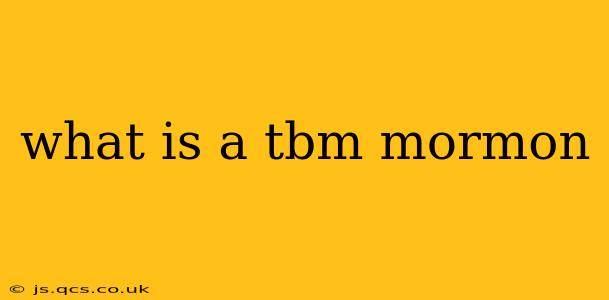The term "TBM Mormon" is shorthand within the Latter-day Saint (LDS) community and online forums referring to a "True Believing Mormon." It describes someone who adheres strictly to the teachings and doctrines of The Church of Jesus Christ of Latter-day Saints, accepting them without significant questioning or dissent. This isn't necessarily a judgmental term, though it can sometimes carry subtle connotations depending on context. Understanding the nuances behind the term requires exploring what it means to be a "True Believer" within the LDS faith.
What defines a "True Believing Mormon"?
A TBM Mormon generally exhibits several key characteristics:
- Strict adherence to Church teachings: This includes accepting the scriptures (the Bible, Book of Mormon, Doctrine and Covenants, Pearl of Great Price) as the word of God, following Church policies and procedures, and believing in the continuing prophetic authority of the Church President.
- Active participation in Church activities: This involves regular attendance at Sunday services, participation in callings (volunteer positions), involvement in various Church organizations (like Relief Society, Young Men, Young Women), and adherence to the Word of Wisdom (a health code).
- Emphasis on traditional family values: This typically involves marriage within the temple, raising children in the faith, and maintaining a strong family unit.
- Acceptance of Church history: TBMs tend to accept the Church's official historical narrative, even in the face of potentially controversial or challenging aspects. While acknowledging complexities, they generally maintain faith in the overall truthfulness of the Church's history.
- Limited questioning of doctrine: While personal study and pondering are encouraged, TBMs generally accept Church doctrines as authoritative without extensive questioning or seeking alternative interpretations.
What are some common misconceptions about TBMs?
It's important to avoid generalizations. While some characteristics might be common among those identified as TBMs, not all individuals fitting this description share every single trait. It's also crucial to avoid stereotyping. TBMs are individuals with diverse personalities, backgrounds, and life experiences. Some common misconceptions include:
- Lack of intellectual curiosity: Many TBMs are deeply engaged in intellectual pursuits, studying scripture, theology, and Church history extensively. The difference lies in how they approach potentially contradictory information or differing viewpoints.
- Blind faith: While TBMs generally express strong faith, this isn't necessarily "blind." Their faith is often rooted in personal experiences, spiritual confirmation, and years of dedicated study and devotion.
- Intolerance: While differing beliefs exist within the Church, it’s incorrect to characterize all TBMs as intolerant. Many TBMs are actively engaged in community service, extending kindness and compassion to others, regardless of religious affiliation.
Are there different levels of "True Believing Mormonism"?
The term "TBM" is a spectrum. There's no singular definition. Someone might be considered a TBM while still having reservations about specific doctrines or practices. The label often reflects a relative stance within the broader LDS community, rather than absolute adherence to every single detail. The degree of adherence and the intensity of beliefs can vary greatly from person to person.
Why is the term "TBM" used?
The term provides a concise way to communicate within online LDS communities and discussions about differing perspectives within the faith. It can simplify conversations, but it's crucial to remember its inherent limitations and avoid using it in a dismissive or derogatory manner. Understanding the nuances of the term is key to navigating discussions about faith and belief within the LDS community.
How does the term relate to other LDS terminology?
The term often contrasts with labels like "inactive," "less-active," or terms used to describe individuals who have left the Church ("ex-Mormon"). However, it's important to note these distinctions aren't always clear-cut, and individual experiences are vastly diverse.
In conclusion, understanding the term "TBM Mormon" requires recognizing its nuanced nature and the diversity within the Latter-day Saint community. It's a descriptor, not a definitive categorization, and should be used with sensitivity and awareness of individual experiences.
